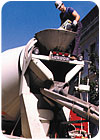
Before there was topical crystalline waterproofing, there was integral crystalline waterproofing. Or better stated, if integral crystalline waterproofing is used, topical application may be unnecessary. In my last article (“Krystolize to Waterproof,” W&C, February 2006), I discussed the uses and advantages of crystalline technology as a surface-applied waterproofing option. In this article, I’ll touch on crystalline technology as applied internally, or actually within poured concrete.
In reality, the topical application is the “prequel.” The admixture was first developed by Kryton from the topical technology. Since the admixture is added to new concrete, it is in effect the prequel to the use of topical applications for repair.
Krystol Internal Membrane, or KIM for short, originated in the early 1980s by Kryton International. Today, there are several manufacturers touting an integral waterproofing admixture.
KIM is a concrete admixture typically added at the concrete plant. It is commonly mixed in the pour at 2 percent of the total cementitious content by weight. KIM essentially does the same thing in a concrete pour as the topical product does - it reacts with the water and unhydrated cement particles to grow billions of tiny crystals that fill all the capillaries and voids found in typical concrete, thus making the concrete impervious to water.
These crystals continue to form with the presence of water, lay dormant if no water is present, but reactivate with the introduction of new water. Again, as long as there is water infiltrating the cement, the crystals will form. Therefore, KIM has self-sealing/self-healing capabilities even years after the initial activation.
Having your poured concrete integrally waterproofed provides multiple advantages:
1KIM concrete keeps water away from metal reinforcing, therefore reducing or eliminating corrosion. By continually filling cavities that allow water migration, the crystal effect blocks pathways for water to reach and “attack” the steel.
2KIM is NSF approved and certified for environments where concrete comes in contact with drinking water.
3KIM concrete is integral to the pour so it eliminates the need for membranes or other waterproofing systems. This in itself offers subsidiary advantages:
A By replacing external systems, space can be saved. Consider the space needed for the application of an external system. In other words, you can extend a building footprint to the outermost limits.
B While saving the space needed for an external application, the jobsite eliminates a major safety issue. Consider external system applicators applying their system in an exterior trench 4 feet wide and possibly several stories deep.
C The KIM application is completed with the pour so there is no time lost waiting or scheduling external systems. Additionally, you are not waiting on the ideal weather conditions often required with external systems.
D KIM doesn’t damage or degrade. External systems can be damaged, slip at seams, and/or wear with UV, chemical, or water exposure.
E KIM is easily installed, added at the concrete batch plant. Most external systems require additional labor. Additionally, the quality of the external system is dependant upon this labor and the installation.
F All the aforementioned advantages also result in direct cost savings. This is attributed to both savings in time and money.
USES ABOUND
KIM concrete has been successfully used in projects all over the world. Projects include, but haven’t been limited to, water treatment plants, tunnels, foundation walls and slabs, swimming pools, even roofs. Take the following project case:In Georgia, the Children’s Healthcare of Atlanta is expanding and renovating several local children’s hospitals, including the Egleston facility, to meet the rapidly growing pediatric population. As part of the upgrades, a new three-level, attached parking garage is being constructed, using a new and innovative method of building shoring walls. Rather than digging down to the required depth and installing shoring walls from the bottom up, the wall is built from the top down.
First, H-beams are punched deep into the ground around the perimeter of the structure to the required depth – in this case, 80 feet (24 meters). Five to six feet of dirt are removed, forms are created on the H-beams, and concrete tiles measuring 7 feet by 4 feet by 9 inches (2.1 m by 1.2 m by 22.5 cm) are poured. Once the concrete sets, the forms are removed, a further six feet of dirt is removed and the process is repeated until the shoring wall is complete.
The general contractor considered using conventional membranes for the project. However, the foundation contractor suggested that he consider the Krystol concrete waterproofing system to save substantially in both money and time.
After preliminary tests proved successful, the general contractor chose the KIM admixture to waterproof the concrete sections in the shoring wall. A total of 39,500 pounds of KIM and 3,500 cubic yards of KIM-treated concrete were used in the Egleston parkade wall, one of the largest shoring wall projects in Atlanta. To protect the joints between the concrete sections, the project team used the Krystol Waterstop System.
The Egleston parkade was recently completed and the entire Egleston Children’s Hospital upgrade will be finished by 2008.
In closing, consider this, typically concrete is at its best after freshly poured, then it gradually degrades as it ages and dries out. It breaks down, spalls, cracks, etc. At this point, as problems occur, topical crack repairs eventually become necessary to save a project. On the other hand, KIM concrete can help to eliminate or avoid these issues if used as the “prequel."
